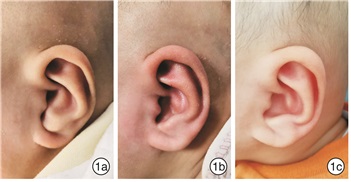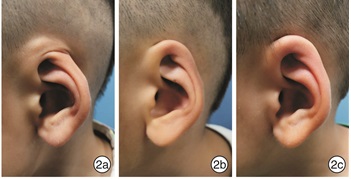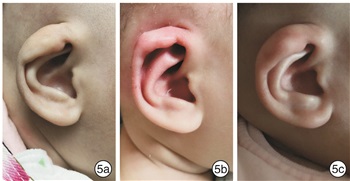Nonsurgical correction of congenital auricular deformities in children older than early neonates
-
摘要: 目的 了解超过3个月的治疗时间窗就诊的不同类型的耳廓形态畸形患儿无创矫正治疗效果、复发情况以及影响因素。方法 收集2017-07—2019-08就诊的耳廓畸形并进行无创矫形的患儿,使用EarWell无创矫正系统进行耳廓矫正,治疗结束后至少随访3个月,收集患儿一般资料,统计治疗效果和复发情况。结果 本组随访结束时收集到76例(88耳)患儿的临床资料,治疗结束时有效率为87.5%,治疗结束后3个月再评估复发率为19.48%,有效组和无效组患儿在耳廓畸形类型分布(P=0.018)和年龄(P=0.028)方面差异有统计学意义,所有的耳廓畸形中隐耳畸形治疗有效率最高,招风耳有效率最低。有效组与无效组在家族史(P=0.314)、性别(P=0.421)、喂养方式(P=0.557)、出生时孕周(P=0.641)以及生产方式(P=0.849)和出生体重(P=0.08)方面差异无统计学意义,复发组与未复发组在首诊时年龄差异无统计学意义(P=0.833),畸形类型分布差异有统计学意义(P=0.013)。排除隐耳畸形后统计,有效组和无效组在首诊年龄和治疗时间方面差异均无统计学意义。结论 对于超治疗时间窗就诊的患儿,影响治疗效果的因素主要是畸形类型。隐耳畸形、耳甲腔畸形和耳轮畸形仍然可以积极尝试无创矫形,招风耳和杯状耳则不建议尝试无创矫形。Abstract: Objective To report the nonsurgical correction of congenital auricular deformities in children older than 3 months, analysis the effect and the recurrence and the influencing factors.Method Patients with auricular deformities who came to our department from July 2017 to August 2019 were collected. EarWell correction was performed for non-invasive correction. Follow-up was performed for at least 3 months after treatment. Data was collected to analysis the effect and the recurrence and the influencing factors.Result At the end of follow-up, 76 cases of 88 ears were collected, at the end of treatment in this group, the efficiency was 87.5%, and the recurrence rate was 19.48%, 3 months after the end of treatment. There was a statistically significant difference in the distribution of auricle deformities(P=0.018) and the age of first treatment(P=0.028) between children in the effective group and those in the ineffective group. Of all the auricle deformities, the treatment of cryptotia was the most effective, and the effectiveness of prominent ears was the lowest. The family history(P=0.314), gender(P=0.421), and feeding method(P=0.557) of the effective and ineffective groups. There was no significant difference in the gestational weeks at birth(P=0.641), the mode of production(P=0.849), and birth weight(P=0.08). There was no significant difference in age between the relapsed group and the non-relapsed group at the age of first treatment(P=0.833).There was significant difference in the distribution of auricle deformities between the relapsed group and the non-relapsed group(P=0.013). There was no statistically significant difference between the effective group and the ineffective group at the age of first diagnosis and treatment time if we exclude cryptotia.Conclusion For children who are treated beyond the treatment time window, the main factor affecting the treatment effect is the type of deformity. Nonsurgical correction can still be tried for older than 3 months with auricular deformities, especially for cryptotia, ear wheel deformities, and auricular cavity deformities. We do not recommend to try nonsurgical correction for children older than 3 months with prominent ears and cup ears.
-
Key words:
- auricular deformities /
- orthotic devices /
- treatment effectiveness
-

-
表 1 各类畸形治疗效果及平均治疗时间和复发情况x±s
畸形类别 耳数 平均治疗时间/d 疗效 显效 有效 无效 复发 垂耳 11 56±2.4 3 6 2 3 耳轮畸形 23 38±1.7 13 8 2 3 隐耳 25 47±3.9 19 6 0 0 招风耳 11 92±7.5 4 3 4 3 杯状耳 8 65±5.4 4 2 2 4 耳甲腔畸形 3 24±1.3 3 0 0 0 混合畸形 7 45±2.4 4 2 1 2 合计 88 49±3.2 50 27 11 15 表 2 有效组和无效组在畸形类型分布和首诊年龄、治疗时间方面的比较
耳,x±s 疗效 畸形类型 平均首诊年龄/d 平均治疗时间/d 垂耳 耳轮畸形 隐耳 招风耳 杯状耳 耳甲腔畸形 混合畸形 有效 9 21 25 7 6 3 6 773±18 35.5±4.6 无效 2 2 0 4 2 0 1 176±12 59.2±5.7 P值 0.018 0.028 0.047 -
[1] Matsuo K, Hirose T, Tomono T, et al. Nonsurgical correction of congenital auricular deformities in the early neoate: a preliminary report[J]. Plast Reconstr Surg, 1984, 73(1): 38-51. doi: 10.1097/00006534-198401000-00009
[2] Byrd HS, Langevin CJ, Ghidoni LA. Ear molding in newborn infants with auricular deformities[J]. Plast Reconstr Surg, 2010, 126(4): 1191-1200. doi: 10.1097/PRS.0b013e3181e617bb
[3] Doft MA, Goodkind AB, Diamond S, et al. The newborn butterfly project: a shortened treatment protocol for ear molding[J]. Plast Reconstr Surg, 2015, 135(3): 577e-583e. doi: 10.1097/PRS.0000000000000999
[4] 齐向东, 周婕. 先天性耳廓畸形无创矫正技术应用及进展[J]. 中国医学文摘(耳鼻咽喉科学), 2017, 32(1): 4-8. https://www.cnki.com.cn/Article/CJFDTOTAL-ZYEB201701004.htm
[5] 王素芳, 邓哲, 韩富根, 等. 2-6月龄婴幼儿先天性耳形态畸形无创矫正的效果观察[J]. 中华耳科学杂志, 2019, 17(4): 527-531. doi: 10.3969/j.issn.1672-2922.2019.04.016
[6] 田野, 王芳, 於娟娟, 等. 先天性耳廓畸形筛查及无创矫正效果分析[J]. 临床耳鼻咽喉头颈外科杂志, 2019, 33(3): 259-261. https://www.cnki.com.cn/Article/CJFDTOTAL-LCEH201903019.htm
[7] 陈沛维, 李洁, 赵守琴, 等. 新型耳矫治器对小儿先天性耳廓畸形治疗效果分析[J]. 临床耳鼻咽喉头颈外科杂志, 2017, 31(11): 849-853. https://www.cnki.com.cn/Article/CJFDTOTAL-LCEH201711008.htm
[8] Sorribes MM, Tos M. Nonsurgical treatment of prominent ears with the Auri method[J]. Arch Otolaryngol Head Neck Surg, 2002, 128(12): 1369-1376. doi: 10.1001/archotol.128.12.1369
[9] Yotsuyanagi T. Nonsurgical correction of congenital auricular deformities in children older than early neonates[J]. Plast Reconstr Surg, 2004, 114(1): 190-191. doi: 10.1097/01.PRS.0000128819.03187.5D
[10] Yotsuyanagi T, Yamauchi M, Yamashita K, et al. Abnormality of Auricular Muscles in Congenital Auricular Deformities[J]. Plast Reconstr Surg, 2015, 136(1): 78e-88e. doi: 10.1097/PRS.0000000000001383
[11] van Wijk MP, Breugem CC, Kon M. A prospective study on non-surgical correction of protruding ears: the importance of early treatment[J]. J Plast Reconstr Aesthet Surg, 2012, 65(1): 54-60.
-





 下载:
下载:



